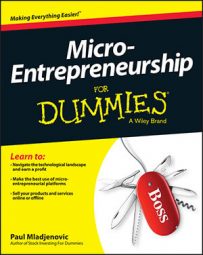The way you communicate with prospects and clients via email can make or break your micro-entrepreneurial business. You need strong email communication to gain your prospects’ trust and their business; make a careless comment or send a poorly written email, and you can lose them
Keep these points in mind when communicating with any prospects or clients.
Read email communications before sending to clients
Before you send an email to any of your micro-entrepreneurial clients or prospects, especially if it’s a sensitive message, read it and then read it again to make sure that your message is clear and compelling and uses the AIDA formula.
The AIDA formula of sales copy writing involves the elements of attention, interest, desire, and action. An email communication can use the AIDA formula to grab the reader’s attention, interest, and desire, while finally spurring them to action.
If you’re writing something negative, have a trusted person read it and give you feedback. Make sure that the email is accurate and that it isn’t communicating anything improper or inflammatory that could get you into trouble (legal or otherwise).
Remember that email is forever
Whenever you send an email (particularly a sensitive one), make it second nature to ask yourself, “If someone read this back to me in five years, would it bother me?”
Today people can indefinitely save data (such as emails). Before you send an email communication, ask yourself whether this email could come back to haunt you. If so, make the appropriate changes to the text and save it in your archive with explanatory remarks so that you know the full details of the email, if necessary.
Know that email communication isn’t the same as talking
Before you send an email, read it to ensure that the tone is appropriate. An email can come off much differently than if the same message were spoken. When humans speak, they get the opportunity to intone their voice to add or subtract meaning, whereas doing the same in written communication can be more difficult.
Think about how many times you’ve received an email and thought, “Gee, that was a snarky response,” and the writer had a different purpose.
Keep email communications simple and clear
Keep your message as focused as possible without any unnecessary words. Use bullet points and short sentences to make your message easier to read, especially because people are reading emails more an more on mobile devices such as laptops, phones, tablets, and smartphones.
Respond quickly to client or prospect emails
Where possible, get back to folks as soon as you can. People like a quick reply, so respond in a timely fashion. If you feel you’ll be away for more than a day or so, consider doing an auto reply that lets your prospects and customers know that you won’t get a chance to reply immediately.
Make sure your email looks professional
In business emails, being professional in both content and style is important. Remember that your email is all about the look. Double-check your grammar, spelling, and punctuation. Don’t use all caps because it looks like you’re shouting. These things don’t convey to your prospect or business contact a strong or positive image of you as a professional, so be extra careful.
If grammar and punctuation aren’t your strong points, have a trusted friend read an email before you send it. Don’t rely entirely on built-in spellcheckers since they do not catch all spelling or grammatical errors.
Don’t share inappropriate content via email
You don’t want to offend your prospects or business clients, so make sure your emails don’t include any offensive or off-the-wall text. Keep emails professional. You don’t want to risk losing any business just to send them a belly laugh about something they may find in bad taste.
Always say please and thank you in your emails
Courtesy goes a long way, both in speaking and in writing. Use it every chance you get in your emails by frequently expressing your appreciation and gratitude. The goodwill it builds can be priceless and may even come in handy later on if a problem or difficulty arises.
Never send an email if you’re angry or upset
Often, people wish they could have called a sent email back after it’s been sent because they’ve said something they later regret. Whenever you’re angry or upset, or if you suspect the other person is and you’re about to send an email, write and save it in your draft folder and wait to send it.
Allow the conversation or email points to circulate in your mind until you’re less upset and have a greater grasp over your thoughts (and emotions).
Use the Send fields in an email correctly
Make sure you know how to use the Send fields in an email. Here is a brief lowdown of the fields:
TO: This field directs the email to the person or people whose attention or action you’re seeking.
CC: Use this field primarily as an FYI. Send copies of emails to people who you want to keep in the loop about something.
BCC: Use this field at your discretion. If you’re sending an email to a large group of people, and you want to respect their privacy, use this field. You can also use this field if you want to keep someone in the loop, but you don’t want the other recipients to know.

